Mag drills, also known as magnetic drill presses, are used in metal fabrication to drill through metal. They are often preferable to stationary drill presses because they’re more versatile but still offer excellent stability. You can drill upside down, sideways and drill larger, deeper holes with an annular cutter. They also offer a lot more stability and power that a hand held drill.
Mag drills work by activating an electromagnet on the base of the drill which attaches it to the workpiece. This locks the drill firmly in place so it does not move while you’re operating it.
Contents
Best Mag Drills Reviewed
1. DEWALT Magnetic Drill Press DWE1622K
![]() Best all-round
Best all-round
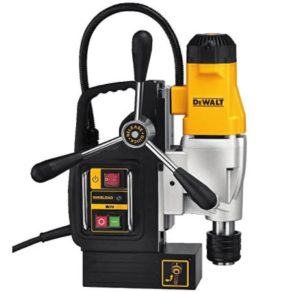 |
|
Our top pick is the DEWALT DWE1622K mag drill, which combines an affordable price with quality manufacturing and some great features. There are two speed settings 300RPM and 450RPM, it’s compact and lightweight which makes it easy to position, the magnet grips really well and it has a cooling tank which can attach to either side of the tool to add cooling fluid to the drill.
You don’t have to worry about overheating as there’s overload protection so it will turn off if it gets too hot and it has an LED indicator on the side to show the heat level to help prevent damage.
This is designed for time saving convenience as well as a high level of performance. There’s an easy to use quick release handle which allows you to switch the handle to either side of the drill without using a tool. There’s also a quick change chuck system allowing you to change the chuck without tools.
|
Specifications
|
Pros
Cons
|
2. Hougen HDM904
![]() Best professional
Best professional
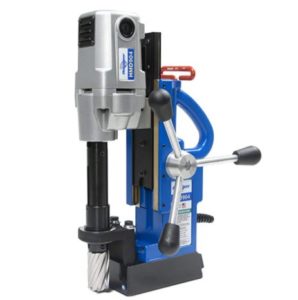 |
|
If you’re willing to spend a few extra bucks then look no further than the Hougen HDM904. This mag drill is made in the US with exceptional build quality. They’re sturdy without being too heavy and don’t wobble when the drill is activated. It’s a solid piece of kit and it’s surprising it’s not heavier, but at 30 lbs it’s one of the most lightweight and compact tools that’s great if you’re doing a lot of work on site.
The HDM904’s best feature is its ability to perfect precise holes. It has a pilot light so you can set the hole location easily and you can also buy one with a swivel base. The swivel base lets you readjust the cutter once the magnet is activated, allowing you easily get better precision or to drill holes next to each other.
|
Specifications
|
Pros
Cons
|
3. Evolution Power Tools EVOMAG42
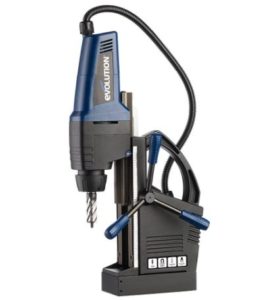 |
|
Evolution Power Tools are a UK company that have created a compact mag drills that’s solidly built and well suited for heavy duty fabrication. This is the most lightweight mag drill in our top picks at just 26 lbs, but its small size doesn’t take anything away from its build quality or performance. Its low weight makes it a great choice for people looking to drill overhead or in confined spaces. It comes with an integrated coolant system and has a max cutter capacity of 1 5/8″ and twist drill capacity of 1/2″. This doesn’t have the features of some of our higher rated drill presses such as quick release functions or a swivel base, but it is competitively priced which makes it a definite tool to consider.
|
Specifications
|
Pros
Cons
|
4. Mophorn Magnetic Drill Press
![]() Best for the money
Best for the money
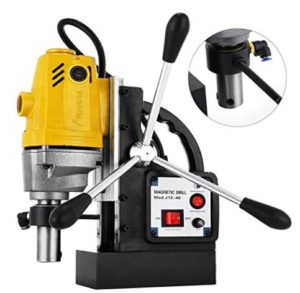 |
|
If you want a really basic tool that will drill holes through metal, the Mophorn magnetic tools are our favorite cheap option. This machine isn’t suitable for deeper holes and only has a 1″ depth of cut compared to 2″ for many more expensive models. The holes will be far from the neatest holes you’ve ever seen, but it will get the job done. It’s lightweight and is great for mobility and is much cheaper than more solidly built similar models. Overall it’s a good choice for a general purpose mag drill that you might not use that often and not require the cleanest holes.
|
Specifications
|
Pros
Cons
|
Why use a mag drill?
A mag drill is a seriously convenient tool to have if you’re going to be drilling holes in metal. Benchtop and standing drill presses are both quite limiting in what they can offer. If you want to drill out on the field on vertical metal beams, then you’ll need a mag drill. Drilling steel with a handheld drill is tiring and you can feel it trying to rip your arm off. Mag drills, in contrast, help decrease fatigue and allow for the large diameter holes to be cut quickly.
Mag drills are particularly useful on construction sites where the drill can be easily attached horizontally or overhead to drill holes in beams. You’ll often see them on construction sites if you keep your eyes out for them.
Another bonus is that they’re still pretty lightweight and portable. A floor standing drill press will constantly take up a huge chunk of your floor, but a mag drill can be stored out of the way and isn’t too heavy to carry.
Which industries use mag drills?
Mag drills are commonly used in steel fabrication, welding shops, mobile repair shops, building and construction, bridge building, ship building, mining, offshore, railroad and more.
How to use a magnetic drill press
Using a mag drill is pretty straightforward. You attach it to the metal you want to drill, line up the annular cutter with the pilot pin, turn on the magnet switch and then slowly feed in the cutter to start drilling. There are a few things you need to have sorted before you can start using a mag drill such as a clean, flat, ferrous metal surface. You must also make sure you are following all the safety instructions outlined in the operating manual.
What type of metal can I drill
The drill will only adhere to ferrous metals. Ferrous metals are metals that contain iron, such as steel, cast iron, stainless steel and steel alloys. You will not be able to drill aluminum or any other non-ferrous metals with a mag drill unless you use a vacuum plate or securely sandwich steel plate around the non-ferrous metal.
Does the metal need to be flat
The steel you’re drilling will need to have a flat surface to allow for maximum adhesion. If the metal isn’t flat then there will be less surface area in contact with the magnet and it won’t attach itself to the surface properly.
Does the surface need to be clean
If the metal is not clean or has a layer of paint over it, this will disrupt the magnetism and it may not adhere effectively. If you’re working outside with moisture in the air, make sure the surfaces are dry and there’s no condensation. You should always check that the magnet is clean and doesn’t have any grease or debris on it before drilling.
What metal thickness can I drill
The magnetic strength experienced by the drill is relative to the thickness of the metal. If the metal is too thin, then the magnet will not be able to adhere to the metal. Mag drills are best for welding metal over ⅜”, if the metal is thinner than this, it might not be able to securely attach itself. If you need to drill thin metal, try clamping an additional piece of steel to the thin steel to help increase the overall magnetism.
Do I need to attach the safety chain
A safety chain should always be used when operating a mag drill to help prevent damage to yourself and the drill. If you’re drilling overheat without the safety chain attached you might accidentally knock the off button if your drill doesn’t have a guard, or you might trip the power, then the drill will fall from the steel and could cause a serious injury or damage to property. Always use a safety chain to protect yourself from these possibilities.
Should I use an annular cutter or twist drill
Most mag drills can use both annular cutters and twist drills. A twist drill is a solid drill bit that drills a hole clean through the metal, grinding through the center of the metal.
An annular cutter is a hollow bit with multiple cutting tips around the perimeter. This cuts out a circle shape from the metal and the center of the hole is removed as a whole piece of metal.
Annular cutters are usually used for holes over ½”. The advantage is that they drill much faster and cleaner than a twist drill because you don’t have to grind through all the metal, it just gets cut out. If you try cutting a ½” hole with a twist drill it will take a long time, but you can be through it in under a minute with an annular cutter.
A twist drill will still provide reliable penetration, but are better suited for small holes. Twist bits are great for drilling precise holes. Twist drill sizes increase in increments of 1/32” compared to 1/16” for annular cutters, so there is greater precision.
Do I need to use lubricating oil
Adding a cutting lubricant is always recommended to help maximise cutter life and reduce heat build up in the drill tips, provide a better finish to the hole and allow for a consistent chip flow. If you don’t use lubricant, the cutter will get ruined pretty quickly, so it’s worth doing to help optimize the tool life. We always use lubricants with annular cutters to help maximize performance and efficiency.
How to choose a mag drill
Weight
Weight can be a pretty big factor when you’re out of the field, especially if you’re going to be drilling overhead or vertical. Our favorite mag drills are ones that are well built and durable, but are compact, portable and easy to position for drilling. If you’re lugging around a 60lb mag drill it’s a lot more dangerous than a 30lb drill. If you’re not drilling massive holes, then a smaller, lightweight machine will be best.
RPM Speed
A slow RPM is good for steel, typically you’ll need to drill slow on harder material when using a larger annular cutter. Most 450rpm drills have a maximum 2” diameter capacity, so you’ll need a slower RPM if you want to drill holes wider than this. Usually the drill will tell you if it’s not happy with the RPM because the metal just won’t chip properly.
Size of hole
Make sure you know what size holes you’ll be looking to drill. The two key measurements are the diameter of hole and the depth of hole (depth of cut). If you’re drilling big holes over 2” then you’ll want a mag drill with multiple speed starts so you can hit the lower RPMs.
Swivel Base
If your holes are required to be quite specific or if you need to drill holes alongside each other, a mag drill with a swivel base is perfect. A swivel base allows you to position your hole more exactly once the magnet is activated. It’s a lot easier than having to deactivate, reposition and reactivate the drill, especially when drilling out vertical or horizontal because you don’t have to support its full weight while you’re adjusting it.
Coolant Bottle
Some mag drills have a cooling bottle attached as part of the machine so you don’t need to manually add lubricant as you drill. A coolant bottle can also be more efficient because a coolant bottle feeds the lubricant through the centre of the cutter, whereas coolant applied by hand can get pushed away by the metal chips before it’s able to come into contact with the cutter.

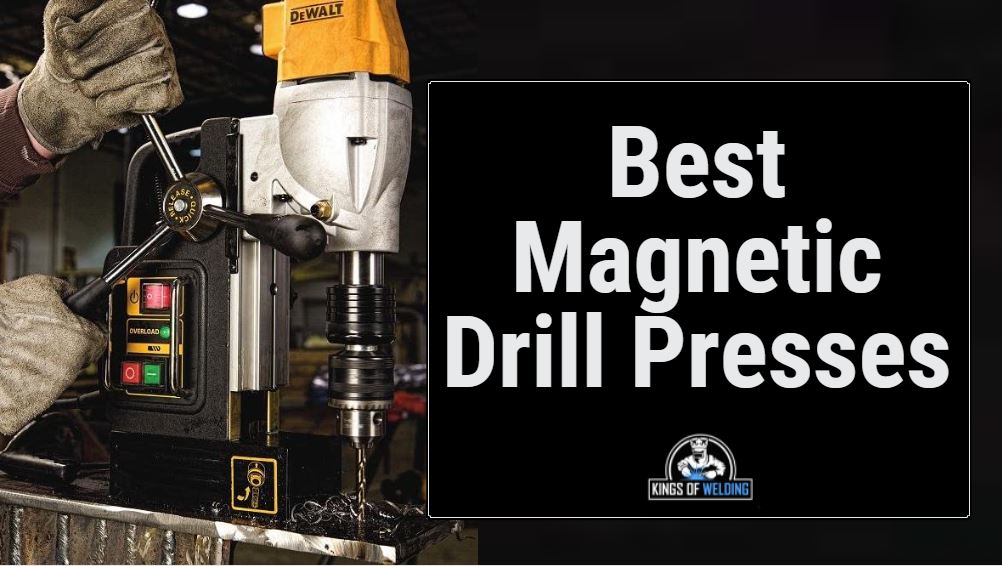
 (5.0 / 5)
(5.0 / 5) (4.5 / 5)
(4.5 / 5) (4.6 / 5)
(4.6 / 5) (4.0 / 5)
(4.0 / 5) (4.4 / 5)
(4.4 / 5) (4.3 / 5)
(4.3 / 5)